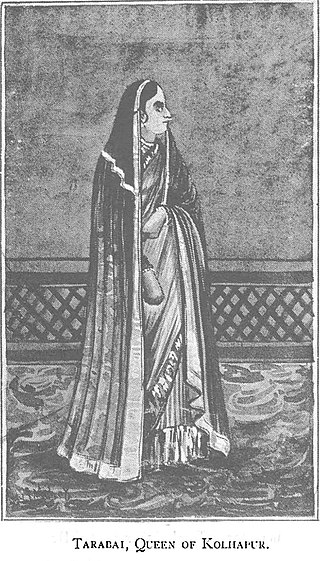
Bajirao I, born as Visaji, was the 7th Peshwa of the Maratha Confederacy. During his 20-year tenure as a Peshwa, he defeated the Nizam of Hyderabad at several battles like the Battle of Palkhed and Battle of Bhopal. Bajirao contributed to Maratha supremacy in Southern India and Northern India. Thus, he was responsible for establishing Maratha power in Gujarat, Malwa, Rajputana and Bundelkhand and liberating Konkan from the Siddis of Janjira and Portuguese rule. He is considered one of the greatest cavalry generals of India.

The Peshwa was second highest office in the Maratha Confederacy, next in rank and prestige only to that of the Chhatrapati. Initially serving as the appointed prime minister in the Maratha empire, the office became hereditary after the death of Shahu in 1749. During the reign of Shahu, the office of Peshwa became incredibly powerful and the Peshwas came to be the de facto rulers of the Maratha empire. However following the defeat of the Marathas in 1761, the office of the Peshwa became titular as well and from that point onwards served as the ceremonial head of the Confederacy underneath the Chhatrapati.

Balaji Vishwanath Bhat (1662–1720) was the first of a series of hereditary Peshwas hailing from the Bhat family who gained effective control of the Maratha Empire and the Mughal vassals of the Marathas during the early 18th century. Balaji Vishwanath assisted a young Maratha king Shahu to consolidate his grip on a kingdom that had been racked by civil war and persistently intruded on by the Mughals under Aurangzeb. He was called the Second Founder of the Maratha State. He secured a grant from the Mughal court that confirmed Shahu as the legitimate Mughal vassal, at the expense of his rival Sambhaji. Later, his son Bajirao I became the Peshwa.

Rajaram Bhonsle I was the third Chhatrapati of Maratha Empire, who ruled from 1689 to his death in 1700. He was the second son of the Shivaji, the founder of the empire and younger half-brother of Sambhaji, who he succeeded. His eleven-year reign was marked with a constant struggle against the Mughals. He was succeeded by his infant son Shivaji II under the regentship of his dowager Maharani Tarabai.

Tarabai Bhosale was the regent of the Maratha Empire of India from 1700 until 1708. She was the empress of Rajaram Bhonsale, and daughter-in-law of the empire's founder Chatrapati Shivaji Maharaj. She is acclaimed for her role in keeping alive the resistance against Mughal occupation of Maratha territories after the death of her husband, and acting as the regent during the minority of her son, Shivaji II.

The Deccan States Agency, also known as the Deccan States Agency and Kolhapur Residency, was a political agency of India, managing the relations of the Government of India with a collection of princely states and jagirs in western India.
Sarpotdar is a family name found mainly among the Maharashtrian people in India. It is derived from the Mughal title Sarpotdar. The Persian word "pota" which means "treasure": the treasurer in Mughal times was called "Potdar" and the chief treasurer would be "Sarpotdar". Later on, the nature of this job changed to somewhat like Inspector General of Currencies.
Pant or Panta is a last name, commonly found in Nepal and in the Indian states of Uttarakhand and Maharashtra. It is a traditional surname used by Brahmins, a priestly community. Foremostly involved in the activities of the state, they were generally found involved in activities such as academics, religion, management, politics and warfare.
Rangnath Narayan Orpe, historically mentioned as ‘Rango Narayan’, was a warrior and administrative officer on Fort Vishalgad, under the regime of Shivaji, founder of the Maratha Empire and his son Sambhaji in the 17th century India. He is mainly known for defeating the Bijapur army in the battle of Vishalgad in July, 1660.

Vishalgad was a jagir during the Maratha Empire and then later part of the Deccan States Agency of the British Raj. It was governed by Deshastha Brahmins, who were feudatories of Kolhapur State.

Ramchandra Neelkanth Bawadekar (1650–1716), also known as Ramchandra Pant Amatya, served on the Council of 8 as the Finance Minister (Amatya) to Emperor (Chhatrapati) Shivaji, dating from 1674 to 1680. He then served as the Imperial Regent to four later emperors, namely Sambhaji, Rajaram, Shivaji II and Sambhaji II. He authored the Adnyapatra, a famous code of civil and military administration, and is renowned as one of the greatest civil administrators, diplomats and military strategists of the Maratha Empire.
Parshuram Trimbak Kulkarni (1660–1718), popularly known as Parshuram Pant Pratinidhi, was a Minister (Pradhan) and Count (Sardar) of the Maratha Empire. He served as Pratinidhi during Rajaram I and Tarabai’s reign. His contribution to the War of 27 years is considered to be of vital importance. He was also the founder of the princely states of Vishalgad and Aundh in Maharashtra.
Pant Pratinidhi family is a prominent aristocratic noble family of India, who served as Pratinidhis to Chhatrapatis of Maratha Empire and later became rulers of the Princely states of Aundh and Vishalgad.

Kolhapur State or Kolhapur Kingdom (1710–1949) was a Maratha princely State of India, under the Deccan Division of the Bombay Presidency, and later the Deccan States Agency. It was considered the most important of the Maratha principalities with the others being Baroda State, Gwalior State and Indore State. Its rulers, of the Bhonsle dynasty, were entitled to a 19-gun salute – thus Kolhapur was also known as a 19-gun state. The state flag was a swallow-tailed saffron pennant.

Aundh State was a Maratha princely state during the British Raj, in the Deccan States Agency division of the Bombay Presidency.
Pralhad Niraji popularly known as Pralhad Pant, was the Pant Pratinidhi of the Maratha Empire during the reign of Chatrapathi Rajaram I. He was the first occupant of the position of Pant Pratinidhi.He is remembered for his splendid contribution in strengthening the Maratha Empire by way of loyalty, diplomacy and exceptional sacrifice.

Shriniwasrao Parshuram, popularly known as Shripatrao Pratinidhi or Shripatrao Pant Pratinidhi, was a General of the Maratha Empire. He served as Pratinidhi during Shahu I's reign. After the death of his father Parshuram Pant Pratinidhi in 1718, Shripat Rao won the favour of Shahu by his brilliant efforts as a soldier fighting many battles in the defence of the Maratha Empire. In 1718, he was appointed as the Pant Pratinidhi of Maratha Empire.

Udaji Chavan (1692-1762), was one of the main supporter and Senapati of Sambhaji II of Kolhapur. He had title of 'Himmat Bahadur'. At first he was partisan of Tarabai. Then afterwards he became the supporter of Samhaji of Kolhapur. He brought territory of Shirol, Raibag under his control. He made 'Battis Shirala' on the bank of Warna as his chief headquarters. He successfully launched many campaign against Shahu with the help of Yashwantrao Thorat.

Sham Raj I ; born as Renuka Das Bhalerao,; popularly known as Raja Sham Raj Rai Rayan, was a general, a statesman, and an Indian noble who served as Prime Minister of Hyderabad. He is also known as Raja Shan Rai Rayan Renuka Das.












